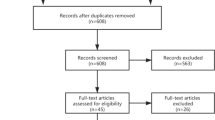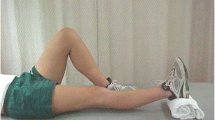Abstract
Purpose
To investigate the mid-term outcomes of an accelerated return to full weight bearing (WB) after matrix-induced autologous chondrocyte implantation (MACI).
Methods
This randomized study allocated 35 patients (37 knees) to a 6 week (n = 18) or 8 week (n = 19) return to full WB after MACI. Patients were evaluated pre-operatively and at 1, 2 and minimum 5 years (range 5.5–7 years), using the KOOS, SF-36, visual analogue pain scale, 6-min walk test and active knee range of motion (ROM). Peak isokinetic knee extensor and flexor strength was assessed, with limb symmetry indices (LSIs) calculated. Magnetic resonance imaging (MRI) was undertaken to evaluate the repair tissue, and an MRI composite score was calculated.
Results
While no group differences (n.s.) were observed, significant improvement was observed for all patient-reported outcome measures (p < 0.05), 6-min walk distance (p = 0.040), active knee flexion (p = 0.002) and extension (p < 0.0001) ROM, and the LSI for peak knee extensor strength (p < 0.0001). At final review, 87.5% (6 weeks) and 82.4% (8 weeks) of patients were satisfied overall. A non-significant decline (n.s.) was observed for the MRI composite score from 1-year post-surgery to final review, with no significant MRI-based differences (n.s.) between groups. At final review, two grafts (6-week n = 1, 8-week n = 1) demonstrated MRI-based graft failure, while an additional patient had progressed toward knee arthroplasty (8.1% failure rate at minimum 5 years).
Conclusions
The 6-week return to full WB after MACI provided comparable clinical and MRI-based outcomes beyond 5 years post-surgery, without jeopardizing the graft. This 6-week WB protocol is faster than those previously proposed and studied.
Level of Evidence
II.

Similar content being viewed by others
References
Barr AJ, Campbell TM, Hopkinson D, Kingsbury SR, Bowes MA, Conaghan PG (2015) A systematic review of the relationship between subchondral bone features, pain and structural pathology in peripheral joint osteoarthritis. Arthritis Res Ther 17:228
Bartlett W, Gooding CR, Carrington RW, Briggs TW, Skinner JA, Bentley G (2005) The role of the Short Form 36 Health Survey in autologous chondrocyte implantation. Knee 12:281–285
Behrens P, Bitter T, Kurz B, Russlies M (2006) Matrix-associated autologous chondrocyte transplantation/implantation (MACT/MACI)—5-year follow-up. Knee 13:194–202
Brittberg M, Lindahl A, Nilsson A, Ohlsson C, Isaksson O, Peterson L (1994) Treatment of deep cartilage defects in the knee with autologous chondrocyte transplantation. N Engl J Med 331:889–895
Brittberg M, Recker D, Ilgenfritz J, Saris DBF, Group SES (2018) Matrix-applied characterized autologous cultured chondrocytes versus microfracture: five-year follow-up of a prospective randomized trial. Am J Sports Med 46:1343–1351
Castaneda S, Roman-Blas JA, Largo R, Herrero-Beaumont G (2012) Subchondral bone as a key target for osteoarthritis treatment. Biochem Pharmacol 83:315–323
Deszczynski J, Slynarski K (2006) Rehabilitation after cell transplantation for cartilage defects. Transplant Proc 38:314–315
Domayer SE, Welsch GH, Dorotka R, Mamisch TC, Marlovits S, Szomolanyi P et al (2008) MRI monitoring of cartilage repair in the knee: a review. SeminMusculoskeletRadiol 12:302–317
Ebert JR, Ackland TR, Lloyd DG, Wood DJ (2008) Accuracy of partial weight bearing after autologous chondrocyte implantation. Arch Phys Med Rehabil 89:1528–1534
Ebert JR, Edwards PK (2014) The evolution of progressive postoperative weight bearing after autologous chondrocyte implantation in the tibiofemoral joint. J Sport Rehabil 23:192–202
Ebert JR, Edwards PK, Fallon M, Ackland TR, Janes GC, Wood DJ (2017) Two-year outcomes of a randomized trial investigating a 6-week return to full weightbearing after matrix-induced autologous chondrocyte implantation. Am J Sports Med 45:838–848
Ebert JR, Fallon M, Ackland TR, Janes GC, Wood DJ (2020) Minimum 10-year clinical and radiological outcomes of a randomized controlled trial evaluating 2 different approaches to full weightbearing after matrix-induced autologous chondrocyte implantation. Am J Sports Med 48:133–142
Ebert JR, Fallon M, Wood DJ, Janes GC (2017) A prospective clinical and radiological evaluation at 5 years after arthroscopic matrix-induced autologous chondrocyte implantation. Am J Sports Med 45:59–69
Ebert JR, Fallon M, Zheng MH, Wood DJ, Ackland TR (2012) A randomized trial comparing accelerated and traditional approaches to postoperative weightbearing rehabilitation after matrix-induced autologous chondrocyte implantation: findings at 5 years. Am J Sports Med 40:1527–1537
Ebert JR, Robertson WB, Lloyd DG, Zheng MH, Wood DJ, Ackland T (2010) A prospective, randomized comparison of traditional and accelerated approaches to postoperative rehabilitation following autologous chondrocyte implantation: 2-year clinical outcomes. Cartilage 1:180–187
Edwards PK, Ackland T, Ebert JR (2014) Clinical rehabilitation guidelines for matrix-induced autologous chondrocyte implantation on the tibiofemoral joint. J Orthop Sports PhysTher 44:102–119
Edwards PK, Ackland TR, Ebert JR (2013) Accelerated weightbearing rehabilitation after matrix-induced autologous chondrocyte implantation in the tibiofemoral joint: early clinical and radiological outcomes. Am J Sports Med 41:2314–2324
Genovese E, Ronga M, Angeretti MG, Novario R, Leonardi A, Albrizio M et al (2011) Matrix-induced autologous chondrocyte implantation of the knee: mid-term and long-term follow-up by MR arthrography. Skeletal Radiol 40:47–56
Gobbi A, Kon E, Berruto M, Filardo G, Delcogliano M, Boldrini L et al (2009) Patellofemoral full-thickness chondral defects treated with second-generation autologous chondrocyte implantation: results at 5 years’ follow-up. Am J Sports Med 37:1083–1092
Goldring MB, Goldring SR (2010) Articular cartilage and subchondral bone in the pathogenesis of osteoarthritis. Ann N Y Acad Sci 1192:230–237
Hambly K, Bobic V, Wondrasch B, Van Assche D, Marlovits S (2006) Autologous chondrocyte implantation postoperative care and rehabilitation: science and practice. Am J Sports Med 34:1020–1038
Hambly K, Bobic V, Wondrasch B, Van Assche D, Marlovits S (2006) Autologous chondrocyte implantation postoperative care and rehabilitation: science and practice. Am J Sports Med 34:1–19
Hirschmuller A, Baur H, Braun S, Kreuz PC, Sudkamp NP, Niemeyer P (2011) Rehabilitation after autologous chondrocyte implantation for isolated cartilage defects of the knee. Am J Sports Med 39:2686–2696
Kon E, Di Martino A, Filardo G, Tetta C, Busacca M, Iacono F et al (2011) Second-generation autologous chondrocyte transplantation: MRI findings and clinical correlations at a minimum 5-year follow-up. Eur J Radiol 79:382–388
Kraeutler MJ, Belk JW, Carver TJ, McCarty EC (2018) Is delayed weightbearing after matrix-associated autologous chondrocyte implantation in the knee associated with better outcomes? A systematic review of randomized controlled trials. Orthop J Sports Med 6:2325967118770986
Kurkijarvi JE, Nissi MJ, Kiviranta I, Jurvelin JS, Nieminen MT (2004) Delayed gadolinium-enhanced MRI of cartilage (dGEMRIC) and T2 characteristics of human knee articular cartilage: topographical variation and relationships to mechanical properties. MagnReson Med 52:41–46
Marlovits S, Singer P, Zeller P, Mandl I, Haller J, Trattnig S (2006) Magnetic resonance observation of cartilage repair tissue (MOCART) for the evaluation of autologous chondrocyte transplantation: determination of interobserver variability and correlation to clinical outcome after 2 years. Eur J Radiol 57:16–23
Marlovits S, Striessnig G, Resinger CT, Aldrian SM, Vecsei V, Imhof H et al (2004) Definition of pertinent parameters for the evaluation of articular cartilage repair tissue with high-resolution magnetic resonance imaging. Eur J Radiol 52:310–319
Mithoefer K, Hambly K, Logerstedt D, Ricci M, Silvers H, Della Villa S (2012) Current concepts for rehabilitation and return to sport after knee articular cartilage repair in the athlete. J Orthop Sports PhysTher 42:254–273
Reinold MM, Wilk KE, Macrina LC, Dugas JR, Cain EL (2006) Current concepts in the rehabilitation following articular cartilage repair procedures in the knee. J Orthop Sports PhysTher 36:774–794
Riegger-Krugh CL, McCarty EC, Robinson MS, Wegzyn DA (2008) Autologous chondrocyte implantation: current surgery and rehabilitation. Med Sci Sports Exerc 40:206–214
Robertson WB, Fick D, Wood DJ, Linklater JM, Zheng MH, Ackland TR (2007) MRI and clinical evaluation of collagen-covered autologous chondrocyte implantation (CACI) at 2 years. Knee 14:117–127
Roos EM, Roos HP, Lohmander LS, Ekdahl C, Beynnon BD (1998) Knee Injury and Osteoarthritis Outcome Score (KOOS)—development of a self-administered outcome measure. J Orthop Sports PhysTher 28:88–96
Tiderius CJ, Tjornstrand J, Akeson P, Sodersten K, Dahlberg L, Leander P (2004) Delayed gadolinium-enhanced MRI of cartilage (dGEMRIC): intra- and interobserver variability in standardized drawing of regions of interest. Acta Radiol 45:628–634
Trattnig S, Pinker K, Krestan C, Plank C, Millington S, Marlovits S (2006) Matrix-based autologous chondrocyte implantation for cartilage repair with Hyalograft((R))C: 2-year follow-up by magnetic resonance imaging. Eur J Radiol 57:9–15
Welsch GH, Mamisch TC, Zak L, Blanke M, Olk A, Marlovits S et al (2010) Evaluation of cartilage repair tissue after matrix-associated autologous chondrocyte transplantation using a hyaluronic-based or a collagen-based scaffold with morphological MOCART scoring and biochemical T2 mapping: preliminary results. Am J Sports Med 38:934–942
Wondrasch B, Risberg MA, Zak L, Marlovits S, Aldrian S (2015) Effect of accelerated weightbearing after matrix-associated autologous chondrocyte implantation on the femoral condyle: a prospective, randomized controlled study presenting MRI-based and clinical outcomes after 5 years. Am J Sports Med 43:146–153
Wondrasch B, Zak L, Welsch GH, Marlovits S (2009) Effect of accelerated weightbearing after matrix-associated autologous chondrocyte implantation on the femoral condyle on radiographic and clinical outcome after 2 years: a prospective, randomized controlled pilot study. Am J Sports Med 37(Suppl 1):88S-96S
Funding
This research received some funding from the National Health and Medical Research Council (ID254622 and ID1003452) and the Hollywood Private Hospital Research Foundation (RF031 and RF050).
Author information
Authors and Affiliations
Corresponding author
Ethics declarations
Conflict of interest
No benefits in any form have been received or will be received from a commercial party related to the subject of this article.
Ethical approval
This research was approved by the Hollywood Private Hospital (HPH145) Human Research Ethics Committee (HREC).
Additional information
Publisher's Note
Springer Nature remains neutral with regard to jurisdictional claims in published maps and institutional affiliations.
Rights and permissions
About this article
Cite this article
Ebert, J.R., Fallon, M., Wood, D.J. et al. An accelerated 6-week return to full weight bearing after matrix-induced autologous chondrocyte implantation results in good clinical outcomes to 5 years post-surgery. Knee Surg Sports Traumatol Arthrosc 29, 3825–3833 (2021). https://doi.org/10.1007/s00167-020-06422-6
Received:
Accepted:
Published:
Issue Date:
DOI: https://doi.org/10.1007/s00167-020-06422-6




